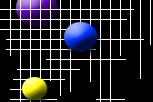From Wikipedia, the free encyclopedia
For other uses, see
Point.
A spatial point is a concept used to define an exact location in space. It has no volume, area or length, making it a zero dimensional object. Points are used in the basic language of geometry, physics, vector graphics (both 2D and 3D), and many other fields. In mathematics generally, particularly in topology, any form of space is considered as made up of an infinite amount of points as basic elements.
[edit] Points in Euclidean geometry
In Euclidean geometry, points are one of the fundamental objects. Originally defined by Euclid as "that which has no part", this essentially means that it has no length, width, depth or any higher dimensional measure of value. In two dimensional space, a point is represented by an ordered pair (a1,a2)
of numbers, where a1 conventionally represents its location on the x-axis, and a2 represents
its location on the y-axis. For higher dimensions, a point is represented by an ordered collection of n elements, (a1,
a2, ..., an) where n is the dimension of the space.
Euclid both postulated and asserted many key ideas about points. His first postulate is that it was possible to draw a
straight line from any point to any other point. This is confirmed in modern day set theory in two dimensions by the set ![F = \{\,x, \frac{y_2 - y_1}{x_2 - x_1}(x - x_1) + y_1 : x \in [x_1, x_2]\,\}](http://upload.wikimedia.org/math/9/8/3/983a334593f501cff5a7c0a4b1531d86.png) , with higher-dimensional analogues existing for any given dimension. Euclid sometimes implicitly assumed facts that did not
follow from the axioms (for example about the ordering of points on lines, and occasionally about the existence of points
distinct from a finite list of points). Therefore the traditional axiomatization of point was not entirely complete and definitive.
, with higher-dimensional analogues existing for any given dimension. Euclid sometimes implicitly assumed facts that did not
follow from the axioms (for example about the ordering of points on lines, and occasionally about the existence of points
distinct from a finite list of points). Therefore the traditional axiomatization of point was not entirely complete and definitive.
Observe that there are also approaches to geometry in which the points are not primitive notions. The notion of "region"
is primitive and the points are defined by suitable "abstraction processes" from the regions (see Whitehead's point-free geometry).

